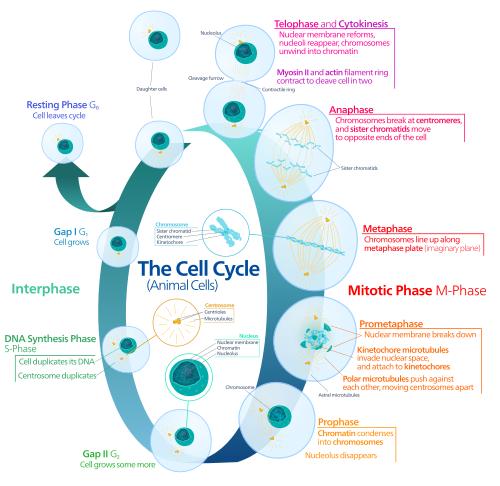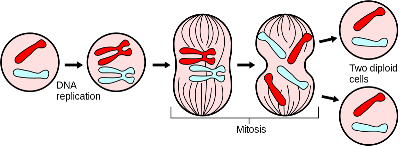Living organisms are constantly creating new cells. They make new cells grow and also to replace old cells that have died. The process by which new cells are made is called cell division. Cell division happens all the time. About two trillion cell divisions occur every day in the average human body!
Types of cell division:
There are three main types of cell division: binary fission, mitosis, and meiosis. Binary fission is used by simple organisms such as bacteria. More complex organisms acquire new cells by mitosis or meiosis.
Mitosis
Mitosis is used when a cell needs to replicate into exact copies of itself. Everything in the cell is duplicated. Two new cells have the same DNA, the same function, and the same genetic code. The original cell is called the parent cell and the two new cells are called the daughter cells. The entire process or cycle of mitosis is described in more detail below.
Examples of cells produced by mitosis include cells in the human body for skin, blood, and muscle.
Cell Cycle for Mitosis
Cells go through different phases known as the cell cycle. The “normal” state of the cell is called the “interphase”. The genetic material is duplicated during the interphase of the cell. When a cell receives a signal that it must duplicate itself, it enters its first mitotic state known as “first period”.
Prophase Phase – During this phase, chromatin condenses into chromosomes and the nuclear membrane and nucleolus are disrupted.
Metaphase – During metaphase, the chromosomes line up along the middle of the cell.
Anaphase – During anaphase, the chromosomes separate and move towards the opposite side of the cell.
Telophase – During telophase, the cell forms two nuclear membranes around each set of chromosomes and the chromosomes unfold. The cell wall then gathers and separates in the middle. Two new cells, or daughter cells, are formed. The division of cells is called mitosis or cell cleavage.

Click on picture for larger view
Meiosis
Meiosis is used when it is time for the whole organism to reproduce. There are two key differences between mitosis and meiosis. First, meiosis has two parts. When meiosis is complete, one cell will produce four new cells instead of just two. The second difference is that the new cells have only half of the original cell’s DNA. This is important for life on Earth because it allows new genetic combinations to occur that give life diversity.
Examples of cells that undergo meiosis include cells used in sexual reproduction called gametes.
Diploid and Haploid
Cells produced from mitosis are called diploid cells because they have two complete sets of chromosomes.
Cells produced by meiosis are called haploid because they have only half the number of chromosomes of the original cell.

Binary Fission
Simple organisms like bacteria undergo a type of cell division called binary fission. First, the DNA replicates and the cell grows to twice its normal size. Then the duplicated DNA strands move to opposite sides of the cell. The cell wall then “pinches” in the middle to form two separate cells.

